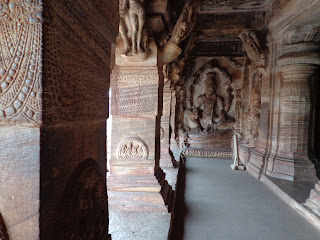Well, last time around, we travelled through the fun and
exotic beaches and along the coastline, covering coveted temples and water
falls on the way. Moving on from the humid, cool and perspiring climate to the
dry, hot and arid climate, we now cover some legacy and architectural
beauty in North Karnataka.
Situated in the district of Bagalkot, are some of the most
famous, globally recognized structures that can make anyone awestruck. The best season to visit them would be from September to January. Its very hot once the summer starts and it becomes tough to wander around.
Now let’s
see through each one of them.
BADAMI:
About 500kms from Bangalore, 100 kms from Hubbali is this
beautiful place called Badami.
This is a hilly region, with the hills formed of sandstone.
Previously known as Vatapi, the caves through these hills once served as the
capital of the Chalukyas.
(View of one of the caves at Badami)
Badami sculptures are a sight to watch and one can find many
inscriptions inside the cave temples.
A whole day is required to explore the entire
caves. A lake, Agasthya tirtha, is found surrounded by the hills. This is a
treat to watch from far off land. In rainy season, one should be lucky enough
to get a glimpse of a few waterfalls formed from the hills.
(View of Agasthya Thirtha)
Badami is well connected via road from Hubballi, Bagalkot
and Bijapur. The nearest airport is Hubbali. A lot of trains ply from
Bangalore.
Around 5 kms from Badami town, is another small village
Banashankari. The temple here is famous, with the deity Shakambari or
Banashankari. She is known to be the incarnation of goddess Parvati. Myth says
that this goddess once came in a merchant’s dream, who was her worshipper, and
provoked him to instill another temple of the same goddess in Bangalore. This
led to the temple in the famous Banashankari area in Bangalore.
(Banashankari Temple)
(View of Badami hills)
(Carvings at Badami)
PATTADAKAL:
Around 35kms from Badami is Pattadakal. This was one of the
significant centers of the Chalukya dynasty. The place is located on the banks
of Malaprabha river and is one of the UNESCO World Heritage sites.
Pattadakal, although not commercially famous as Badami, is
known for the Dravidian style temples built during the Chalukya era. There is
Hindu temple complex, with multiple temples in a single location and a Jain
temple, about a km from this complex.
(Pattadakal Temple complex)
The temple and the deity are not worshipped as the temple complex has been subjected to raids multiple times since the 13th century.
However, the remains still are a reminiscent of the culture, architecture.
(Jain Temple at Pattadakal)
A lot of commute is available from Badami. One can hire a
cab or can catch a bus that ply to this place.
(Carvings at Pattadakal)
AIHOLE:
Another monumental place, along with Badami and Pattadakal,
that took up importance as a heritage spot is Aihole. About 10kms from
Pattadakal and 35kms from Badami, is this small village with a temple complex
spread across acres.
(Temple at Aihole)
Aihole, again, was constructed during the Chalukya era. This
follows the same Pattadakal type having temples in Dravidian style. There is a
Hindu temple complex, a Jain temple complex and a Buddhist temple. Later, the
place was maintained by the Rashtrakuta dynasty.
Like Pattadakal, Aihole too was subjected to multiple raids,
which resulted in many important statues and monuments going missing.
Once a cab is hired, Aihole can be reached easily. Again, several
buses ply from Badami.
The monuments as Badami-Aihole-Pattadakal are a beauty to
watch and worth a visit. Archeologists still work here and try to excavate
remains which may lead to history being unfolded. These monuments also showcase
the existence of dynasties, their rule and the interaction between northern and
southern style of architectures.
Other places to visit:
Some of the other nearby places that can be visited include
Almatti dam and Koodala Sangama.
Almatti dam is the hydro-electric power station built across
the Krishna river. There is a garden called a rock hill garden which makes it a
picnic spot.
(Almatti Dam)
Koodala Sangama is a place where the Malaprabha river joins
the Krishna river. The place is located on the banks of the river where these two
rivers meet. This is one of the tourist attractions and an important religious
place for the Lingayats, one of the faiths followed in the state. Also, this
place includes the holy Samadhi or the Aikya mantapa of the great reformer
Basavanna, the founder of the Lingayat faith.
The place is around 40kms from the city of Bagalkot and
40Kms from Badami. This has good road connectivity with Bijapur, Raichur and
Bagalkot.
(Aikya Mantapa of Basavanna)
(Koodala Sangameshwara temple)

















Beautiful ❤️
ReplyDelete